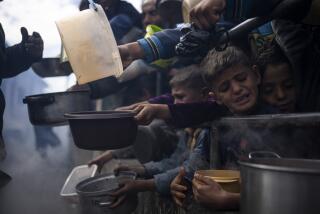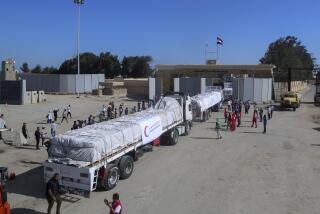COLUMN LEFT/ ALEXANDER COCKBURN : Bad Idea From the Start : In terms of political and social stabilization for Somalia, ‘Restore Hope’ has failed.
- Share via
Three months after U.S. Marines waded ashore in Somalia, the kindest thing that can be said for Operation Restore Hope is that it offers a pithy lesson in the folly of such military interventions. The lessons are applicable to Bosnia and other future targets of merciful opportunity.
First rule: Get the facts straight. By the time George Bush set Operation Restore Hope in motion, the worst of the famine was over and the more efficient relief organizations were supervising relatively secure distribution of emergency food.
The famine peaked between last April and August, with dreadful privation and loss of life. Food production had been disrupted by the civil war and the final flight of dictator Mohammed Siad Barre. At the peak of the disaster, 1,000 people a day were dying.
But by September, the summer harvest had come on, and there were actually food surpluses in the lower Shebeelle region west of Mogadishu. Mortality is a lagging indicator of famine, and the victims on the downward slope from a famine’s peak tend to die from the legacy of undernutrition: epidemic diseases.
There were also misrepresentations about the attrition rate of food shipments. CARE--the subcontractor for USAID and the United Nations--was the most urgent lobbyist for major U.S. intervention, and claimed an 80% loss from looting. But more efficiently run outfits such as the Red Cross, Save the Children (U.K.) and Oxfam confirm that their losses were under 20%.
Between Dec. 9, 1992--the day the Marines went ashore--and the end of January, the U.S. mission escorted 30,000 tons of food shipments. For most of that period, the port of Mogadishu was choked by the logistical requirements of the U.S. force, and the shipments had to be brought in by air at staggering expense. Meanwhile, during the same period, the Red Cross, which has steadfastly declined military escorts, moved 18,000 tons.
There are rural pockets where the situation still is very grim, but a big problem for many Somali farmers now is that they have food surpluses they can’t sell because prices are undercut by the aid shipments. So charity favors the export farmers of the American Midwest at the expense of their Somalian opposite numbers, who are either undercut or unable to farm because they have been mustered into displacement camps.
Second rule: Military intervention doesn’t solve problems; it changes them. Before Operation Restore Hope, the main security problem was in the towns. After Dec. 9, the gunmen went to the countryside, where looting and diversion of food supplies soared.
Any agreement negotiated with the sanction of 30,000 troops will hold only so long as that force remains. There is no sign that the diplomatic and military leaders of the U.S. force have fostered the civil infrastructure necessary to achieve long-term disarmament and reconstruction. If anything, the power of the warlords has been enhanced by these U.S. viceroys, among whom must be counted the officials of CARE who have been fostering the deadly notion that Somalia is a long-term basket case.
Rakiya Omaar, a Somali and former head of the human-rights organization Africa Watch, reports after a recent visit that the marginalization of Somalis is a constant humiliation. Somali professionals, Omaar says, have grown steadily more furious and despairing as their talents are ignored by the new “humanitarian” empire builders.
This anger blends with a mounting popular resentment at casual rules of military engagement that have seen dozens of Somalis killed with little subsequent investigation. At Beledweyne, north of Mogadishu, Canadian troops under the U.N. colors recently felt that their lives were under threat and fired into a crowd predominantly made up of women and children, killing several. A recent attack on U.S. forces started as a spontaneous popular outburst at what many Somalis apparently see as the arrogance and aggressiveness of the U.S. troops.
Has Operation Restore Hope achieved anything? Bringing all factions to the meeting in Addis Ababa was a solid achievement, though it is possible that the U.N. negotiator who was fired last October, Mohammed Sahnoun, would eventually have arrived at the same objective.
In terms of lives saved, it is debatable whether the dislocations and deaths caused by the arrival of the large U.S. force were outweighed by the lives saved with shipments under the protection of that force. In terms of long-term political and social stabilization of Somalia, the operation has been a predictable failure, from which the United States now hopes to extricate itself, declaring victory and leaving the field in charge of a United Nations more discredited than ever before.
More to Read
Sign up for Essential California
The most important California stories and recommendations in your inbox every morning.
You may occasionally receive promotional content from the Los Angeles Times.













